Introduction to Patterns in Budgerigars
Budgerigars, often affectionately known as budgies, are one of the most popular pet birds worldwide. A significant reason for their popularity is their vibrant and diverse color patterns. Understanding these patterns in budgerigars not only enhances our appreciation for these charming birds but also aids in their identification and care.
Budgies exhibit a fascinating array of patterns and color variations, from common stripes and spots to rare and unique patterns like opaline and spangle. These patterns are not just visually appealing; they are also a reflection of the complex genetic traits that budgerigars possess.

A charming trio of budgerigars showcasing their colorful patterns while perched on a tree trunk.
In this guide, we’ll explore the different patterns in budgerigars, how these patterns develop, and what factors influence them. We’ll also explore the process of breeding budgies for specific patterns, ensuring you have all the knowledge you need to identify and appreciate the wide variety of Budgerigar patterns.
Whether you’re a seasoned budgie enthusiast or a curious newcomer, this comprehensive guide will provide valuable insights into the beautiful and intricate world of Budgerigar patterns. So, let’s start this colorful journey and discover the amazing diversity that makes each budgie unique.
Understanding Budgerigar Color Genetics
The world of budgerigars is not only colorful but also genetically fascinating. Understanding the color genetics of budgerigars is key to appreciating the variety of patterns and hues these birds can exhibit. This knowledge is particularly valuable for those interested in breeding budgies for specific patterns and colors.
Budgerigar color genetics can initially seem complex, but it boils down to a few basic principles. The colors and patterns in budgerigars are determined by genes inherited from their parents. These genes can produce a wide range of combinations, leading to the diverse patterns in budgerigars we see today.
Basic Color Genes
Budgerigars have two primary color bases: green and blue. The green color is dominant, while the blue is recessive. This means that a budgie will display green if it has at least one green gene. For a budgie to be blue, it must have two blue genes, one from each parent.
Pattern Genes
In addition to the basic colors, various genes influence the patterns in budgerigars. Some of the most common patterns include:
- Stripes and Spots: These are the hallmark of many budgerigars, especially in wild types.
- Opaline: This pattern alters the distribution of stripes and changes the overall appearance of the budgie’s plumage.
- Spangle: Budgies with this pattern have distinct, star-like marks on their feathers.
Inheritance and Breeding
When breeding budgies for specific patterns, it’s essential to understand how these genes interact. For instance, if you breed two budgies with dominant green genes, their offspring will likely be green. However, if you pair a green budgie with a blue one, you could get a mix, depending on the genetic makeup of the green parent.
Breeding budgerigars with unique patterns, like the opaline or spangle, requires careful selection of breeding pairs. Knowledge of their genetic background can help predict the patterns and colors of the chicks.

A comprehensive chart illustrating the dominant and recessive traits in budgerigar genetics.
Genetic Influences and Mutations
Beyond the basic and pattern genes, mutations can also occur, leading to rare and unique patterns in budgerigars. These genetic mutations can result in pied, clearwing, and lacewing patterns, adding even more diversity to the budgie population.
Understanding budgerigar color genetics is not only fascinating but also practical for breeding and caring for these birds. It helps ensure that the beauty of their patterns is preserved and appreciated for generations to come. As you dive deeper into the genetics of budgerigars, you’ll find a world rich with possibilities and endless combinations.
Common Patterns in Budgerigars
Budgerigars, with their delightful variety of patterns and colors, are a joy to observe and care for. Understanding the common patterns in budgerigars can enhance your appreciation for these fascinating birds and aid in their identification. Here, we’ll explore some of the most frequently seen patterns in budgies.
Stripes and Spots
One of the most recognizable patterns in budgerigars is the combination of stripes and spots. These markings are typically found on the head, wings, and back of the bird. Wild-type budgerigars, which are usually green, display dark, well-defined stripes and spots. These patterns provide camouflage in their natural habitat, helping them blend into the foliage.
Opaline Pattern
The opaline pattern is a popular and visually striking variation. Budgerigars with this pattern have a reduced amount of stripes on their wings and back. The body color appears more evenly distributed, and the head markings are less pronounced. This pattern gives the budgie a softer, more blended appearance, making it a favorite among budgie enthusiasts.
Spangle Pattern
Spangle budgerigars are known for their unique and eye-catching feather markings. The spangle pattern modifies the typical black and white markings on the wings, creating a star-like or spangled effect. These birds often have a lighter, more contrasting color on their feathers, making the spangle pattern stand out prominently.
Understanding these common patterns in budgerigars helps in identifying and appreciating the diverse beauty of these birds. Whether you’re a breeder looking to produce specific patterns or a budgie owner admiring your pet, recognizing these patterns can enrich your experience with these delightful creatures.
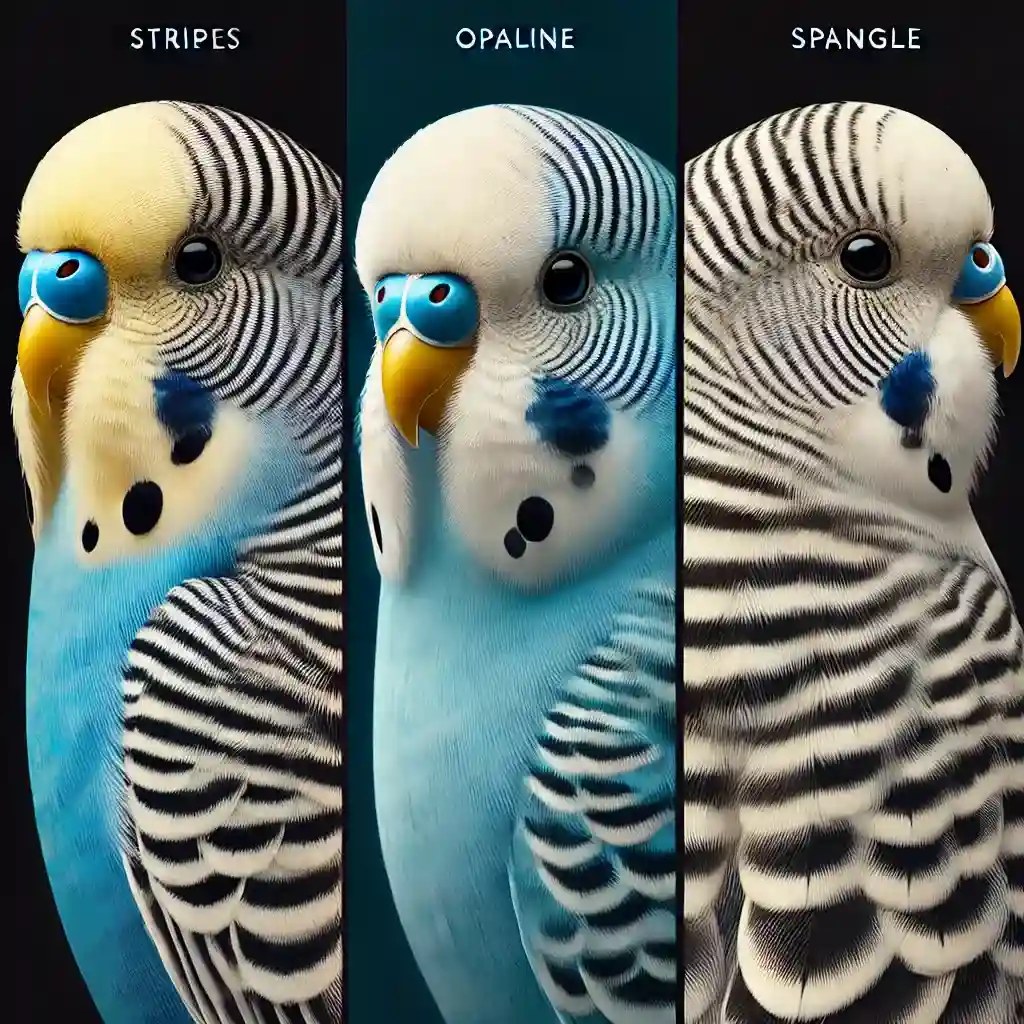
Comparative display of budgerigar feather patterns: stripes, opaline, and spangle.
Rare and Unique Patterns in Budgerigars
While common patterns in budgerigars are delightful, the rare and unique patterns are what truly capture the fascination of budgie enthusiasts. These less common patterns add a layer of intrigue and beauty to the already vibrant world of budgerigars. Let’s explore some of these rare and unique patterns in budgerigars.
Pied Pattern
The pied pattern is one of the most sought-after and unique patterns in budgerigars. Pied budgies exhibit irregular patches of color and white, creating a distinct and unpredictable appearance. The degree and placement of these patches vary greatly from bird to bird, making each pied budgie truly one of a kind. This pattern can be seen in several variations, including dominant pied, recessive pied, and Australian pied.
Clearwing Pattern
Clearwing budgerigars are known for their almost translucent wings, which lack the usual dark markings. Instead, these budgies have clear or lightly shaded wings, creating a striking contrast with their vibrant body color. This pattern is rare and highly prized among breeders and budgie enthusiasts for its elegant and refined look.
Lacewing Pattern
Lacewing budgerigars possess a delicate and ethereal pattern that combines elements of albino or lutino coloring with soft, lace-like markings. These markings are typically light and subtle, giving the bird a gentle and elegant appearance. The lacewing pattern is rare and adds a touch of sophistication to the budgie’s overall look.
Fallow Pattern
The fallow pattern is another unique and less common variation. Fallow budgerigars have lighter, cinnamon-colored markings instead of the usual dark ones. Their eyes also have a distinctive red or plum color. This combination of lighter markings and eye color gives fallow budgies a soft and warm appearance, making them stand out among other budgies.
Anthracite Pattern
The anthracite pattern is one of the rarest in budgerigars. Birds with this pattern exhibit a dark, almost black body color with subtle variations in shading. This pattern is extremely rare and is the result of a specific genetic mutation. Anthracite budgies are highly coveted for their unique and striking appearance.
Rainbow Pattern
The rainbow pattern is a visually stunning combination of various mutations, resulting in a budgie that showcases multiple colors in a gradient or patchwork effect. These birds often display hues of blue, green, yellow, and violet, creating a rainbow-like appearance. The complexity and beauty of the rainbow pattern make it a rare and treasured sight.
Saddleback Pattern
Saddleback budgerigars have a distinctive pattern where the coloration forms a “saddle” shape on their back, leaving the rest of the body a different color. This pattern is rare and gives the bird a unique and striking look. The saddleback pattern is highly prized for its unusual and eye-catching appearance.
Texas Clearbody Pattern
The Texas clearbody pattern is a fascinating and unique variation where the body is nearly free of dark markings, and the wings are lightly shaded. This creates a stark contrast between the clear body and the lightly marked wings. The Texas clearbody pattern is rare and admired for its clean and striking look.
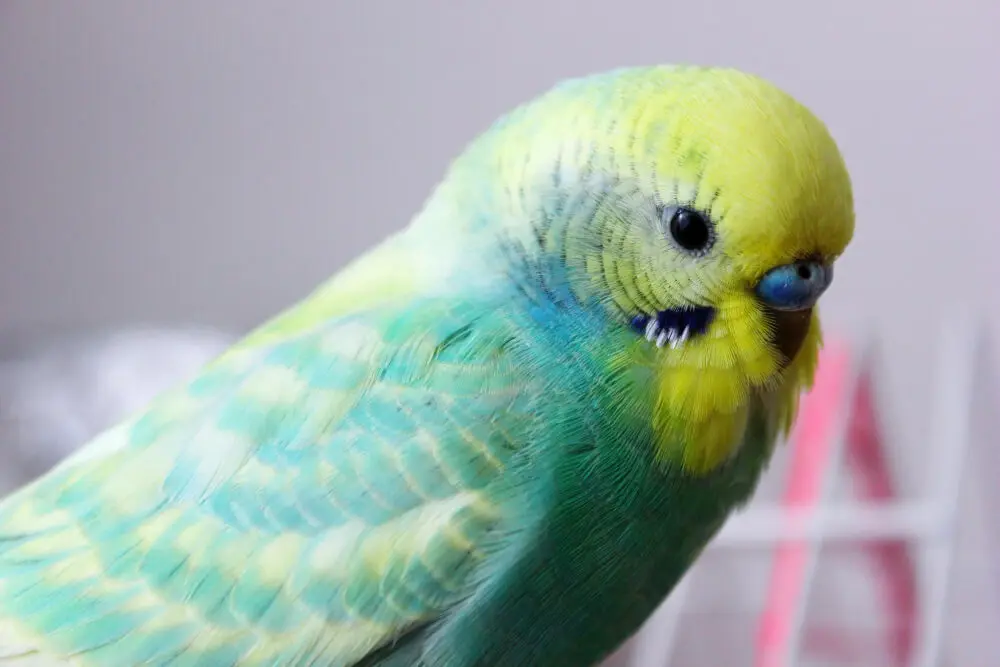
A close-up view of a green and yellow budgerigar, highlighting its delicate feather patterns.
Crested Pattern
Crested budgerigars have a unique feature that sets them apart: a crest of feathers on their head. This pattern can vary from a small tuft to a full, rounded crest. The crested pattern is rare and adds an extra layer of charm and uniqueness to the budgie’s appearance.
Understanding and recognizing these rare and unique patterns in budgerigars not only enhances our appreciation for these beautiful birds but also provides valuable insights for breeding and care. Each rare pattern adds to the rich tapestry of budgerigar diversity, making these birds even more fascinating and delightful to observe.
Factors Influencing Pattern Development
Patterns in budgerigars are not only visually appealing but also a result of complex genetic and environmental influences. Understanding the factors that influence pattern development in budgerigars can provide valuable insights for breeders and enthusiasts alike. Let’s explore the key factors that contribute to the stunning variety of patterns in these delightful birds.
Genetic Factors
The primary determinant of patterns in budgerigars is their genetic makeup. Each budgie inherits a combination of genes from its parents, which influence its color and pattern. Specific genes control the distribution of colors and markings on the bird’s feathers. Some key genetic factors include:
- Dominant and Recessive Genes: Dominant genes will typically express themselves in the bird’s appearance, while recessive genes require both parents to contribute the same gene for the trait to appear.
- Mutations: Genetic mutations can lead to unique and rare patterns in budgerigars. These mutations can occur spontaneously or be selectively bred to enhance certain traits.
- Genetic Combinations: The combination of genes from both parents can result in a wide range of patterns, making each budgie unique.
Environmental Influences
While genetics play a crucial role, environmental factors can also influence pattern development in budgerigars. These factors might not alter the genetic makeup, but they can impact the expression of certain traits. Some important environmental influences include:
- Diet and Nutrition: Proper nutrition is essential for the healthy development of budgerigars. A balanced diet rich in vitamins and minerals supports optimal feather growth and can enhance the vibrancy of their patterns.
- Health and Well-being: Overall health affects feather quality and pattern expression. Healthy budgerigars are more likely to display well-defined patterns and vibrant colors.
- Breeding Conditions: The conditions under which budgerigars are bred, including temperature, humidity, and stress levels, can influence pattern development. Ensuring a stable and stress-free environment promotes the best expression of patterns.
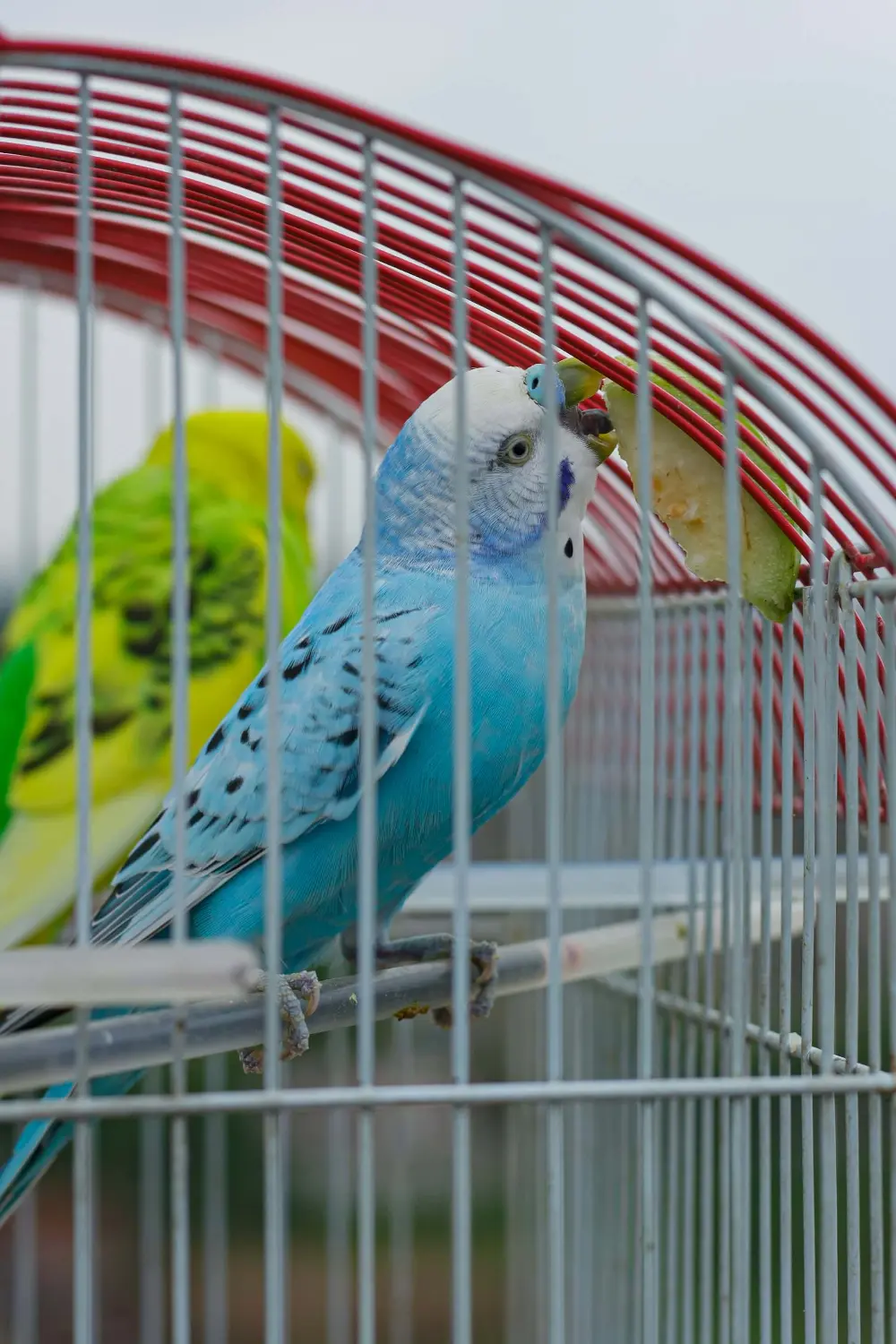
Budgerigars feeding inside a cage, displaying their vibrant feather patterns.
Breeding Practices
Selective breeding is a key factor in developing specific patterns in budgerigars. Breeders carefully choose pairs based on their genetic traits to enhance desired patterns and reduce undesirable ones. Some aspects of breeding practices that influence pattern development include:
- Line Breeding: This practice involves breeding budgerigars within a specific family line to preserve and enhance certain traits.
- Outcrossing: Introducing new genetic material by breeding with unrelated birds can introduce new patterns and reduce the risk of genetic issues.
- Record Keeping: Detailed records of breeding pairs and their offspring help breeders understand the inheritance of patterns and make informed breeding decisions.
Age and Molting
As budgerigars age and go through molting cycles, their patterns can change slightly. Molting is the process where birds shed old feathers and grow new ones. During this time, the new feathers may exhibit variations in pattern intensity and distribution. Age-related changes can also affect the sharpness and clarity of patterns.
The development of patterns in budgerigars is a fascinating interplay of genetic and environmental factors. By understanding these influences, breeders and enthusiasts can better appreciate the beauty and diversity of these birds. Whether you’re breeding budgies for specific patterns or simply admiring their natural beauty, knowing the factors that influence pattern development adds depth to your experience with these charming creatures.
Breeding Budgerigars for Specific Patterns
Breeding budgerigars for specific patterns is a rewarding endeavor that combines genetics, careful planning, and a bit of patience. By understanding the factors that influence pattern development and employing strategic breeding practices, you can enhance and refine the patterns in your budgerigar flock. Here’s a guide to help you get started with breeding budgerigars for specific patterns.
Selecting Breeding Pairs
The first step in breeding budgerigars for specific patterns is selecting the right breeding pairs. Look for budgies that exhibit the desired patterns and colors you want to reproduce. Consider the following when choosing your breeding pairs:
- Genetic History: Understanding the genetic background of your budgerigars is crucial. Birds with a known history of the desired pattern are more likely to pass on these traits to their offspring.
- Health and Vitality: Choose healthy, vigorous birds for breeding. Healthy parents are more likely to produce strong, viable chicks with well-defined patterns.
- Complementary Traits: Select pairs that complement each other’s traits. For example, if one bird has a strong spangle pattern but lacks vibrant color, pairing it with a vividly colored mate can enhance the overall appearance of the offspring.
Understanding Genetic Inheritance
Breeding budgerigars for specific patterns requires a basic understanding of genetic inheritance. Here are some key points to keep in mind:
- Dominant and Recessive Genes: Dominant genes are more likely to be expressed in the offspring, while recessive genes require both parents to carry the gene for the trait to appear.
- Mutation Genes: Some patterns result from specific mutations. Knowing which mutations produce the desired pattern can help you select appropriate breeding pairs.
- Predicting Outcomes: While breeding can be unpredictable, understanding the genetic makeup of your birds allows you to make more informed predictions about the patterns that may appear in the chicks.
Breeding Techniques
Several breeding techniques can help enhance specific patterns in budgerigars. Here are a few methods commonly used by breeders:
- Line Breeding: This technique involves breeding closely related birds, such as siblings or parent-offspring pairs, to reinforce desirable traits. Line breeding can help stabilize patterns within a lineage.
- Outcrossing: Introducing new genetic material by breeding with unrelated birds can introduce new patterns and improve overall genetic diversity. This technique helps reduce the risk of genetic defects.
- Selective Breeding: Carefully selecting and pairing birds based on their traits allows breeders to focus on enhancing specific patterns. Over time, selective breeding can produce more consistent and refined patterns.
Managing Breeding Conditions
Creating the right environment for your breeding pairs is essential for successful pattern development. Here are some tips for managing breeding conditions:
- Nest Boxes: Provide suitable nest boxes for breeding pairs. Ensure the boxes are clean, spacious, and positioned in a quiet, undisturbed area.
- Nutrition: Offer a balanced diet rich in vitamins, minerals, and protein to support the health and vitality of your breeding pairs. Nutritional supplements can also enhance feather quality and pattern expression.
- Health Care: Regular health check-ups and proper veterinary care are crucial for maintaining the health of your breeding birds. Healthy parents are more likely to produce robust chicks with desirable patterns.

A pair of budgerigars in a wooden nesting box, showcasing their unique feather patterns.
Monitoring and Record Keeping
Keeping detailed records of your breeding pairs, their offspring, and the patterns expressed is vital for successful breeding. Monitor the development of patterns in the chicks and note any variations or new traits. Accurate record-keeping helps you track genetic trends and make informed decisions for future breeding projects.
Breeding budgerigars for specific patterns is a fascinating and fulfilling pursuit. By selecting the right breeding pairs, understanding genetic inheritance, and employing effective breeding techniques, you can enhance the beauty and diversity of patterns in your budgie flock. With patience and careful management, you’ll be rewarded with stunning budgerigars that showcase the unique and intricate patterns you’ve worked to achieve.
Caring for Budgerigars with Unique Patterns
Budgerigars with unique patterns are a delight to own and care for. Their distinctive markings make them stand out, but these beautiful birds also require specific care to maintain their health and vibrancy. Here’s a guide to ensure your patterned budgerigars stay healthy and happy.
Diet and Nutrition
A well-balanced diet is crucial for budgerigars, especially those with unique patterns. Their feather health and overall vitality depend significantly on what they eat. Here’s what to include in their diet:
- Quality Seeds and Pellets: A mix of high-quality seeds and pellets forms the foundation of a budgie’s diet. Pellets are particularly beneficial as they provide balanced nutrition.
- Fresh Fruits and Vegetables: Incorporate fresh produce like carrots, broccoli, apples, and spinach into their diet. These are rich in vitamins and minerals that support feather health.
- Calcium Supplements: Provide cuttlebones or mineral blocks to ensure they get enough calcium, essential for their overall health.
- Egg Food: During molting or breeding, egg food can provide extra protein to support feather growth and maintenance.
Health Monitoring
Regular health check-ups and monitoring are vital to catch any issues early and keep your budgerigars with unique patterns in top condition.
- Routine Vet Visits: Schedule regular check-ups with an avian vet to monitor their health and address any concerns promptly.
- Watch for Signs of Illness: Keep an eye out for signs of illness such as changes in droppings, feather plucking, or lethargy. Early detection is key to effective treatment.
- Feather Care: Unique patterns can sometimes indicate underlying genetic conditions. Ensure their feathers are clean and well-maintained, and seek veterinary advice if you notice any unusual changes.
Housing and Environment
Creating a safe, clean, and stimulating environment is crucial for the well-being of your budgerigars.
- Spacious Cage: Provide a spacious cage that allows your budgie to move around freely. The cage should be large enough to accommodate perches, toys, and food dishes without crowding.
- Cleanliness: Regularly clean the cage, perches, and toys to prevent the build-up of bacteria and parasites. Clean water should always be available.
- Toys and Enrichment: Provide a variety of toys to keep your budgie mentally stimulated. Rotate toys regularly to keep them engaged and prevent boredom.
Social Interaction
Budgerigars are social birds and thrive on interaction, both with their human caregivers and other budgies.
- Companionship: If possible, keep budgerigars in pairs or small groups. They enjoy the company and it helps them stay active and happy.
- Human Interaction: Spend time interacting with your budgie daily. Talk to them, offer them treats, and let them out of the cage for supervised playtime.
- Training and Bonding: Train your budgie with simple tricks or commands. This not only strengthens your bond but also provides mental stimulation.
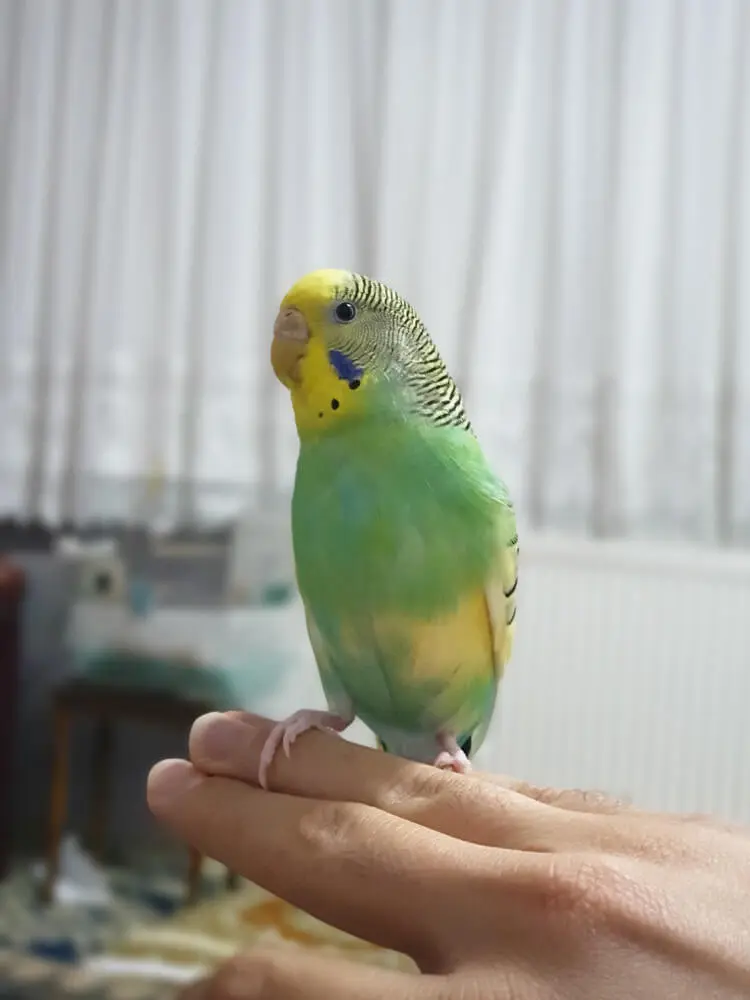
A tame budgerigar perched on owner’s hand, displaying its colorful feather patterns.
Special Considerations for Unique Patterns
Budgerigars with unique patterns might have specific needs depending on their genetic background.
- Regular Molting: Be aware that some unique patterns might affect molting cycles. Provide additional nutritional support during these times.
- Genetic Health Issues: Certain patterns can be linked to genetic conditions. Stay informed about any potential health issues associated with your budgie’s pattern and consult with your vet.
Caring for budgerigars with unique patterns involves attentive feeding, regular health monitoring, and providing a stimulating environment. By understanding their specific needs and ensuring they receive the best possible care, you can enjoy the beauty and charm of these uniquely patterned birds for many years. Their vibrant and distinct markings are a testament to the care and love you provide, making them a treasured part of your avian family.
FAQs about Patterns in Budgerigars
1. What are the most common patterns in budgerigars?
The most common patterns in budgerigars include stripes and spots, opaline, spangle, pied, clearwing, and lacewing. These patterns vary in their distribution and appearance, making each budgie unique.
2. How do genetics influence Budgerigar patterns?
Genetics play a crucial role in determining Budgerigar patterns. Dominant and recessive genes inherited from parent birds influence the color and markings of the offspring. Specific genetic mutations can also result in unique and rare patterns.
3. Can I breed budgerigars for specific patterns?
Yes, you can breed budgerigars for specific patterns by selecting breeding pairs with the desired traits. Understanding genetic inheritance and employing techniques like line breeding, outcrossing, and selective breeding can help achieve specific patterns in the offspring.
4. What factors besides genetics affect Budgerigar patterns?
Environmental factors such as diet, health, and breeding conditions can influence pattern development. Proper nutrition, a healthy environment, and careful management of breeding conditions are essential for the optimal expression of patterns.
5. What are some rare and unique patterns in budgerigars?
Some rare and unique patterns in budgerigars include the fallow, anthracite, rainbow, saddleback, Texas clearbody, and crested patterns. These patterns result from specific genetic mutations and are highly prized among budgie enthusiasts.
6. How can I ensure my budgerigars with unique patterns stay healthy?
To keep budgerigars with unique patterns healthy, provide a balanced diet, regular veterinary check-ups, and a clean, spacious living environment. Social interaction and mental stimulation are also important for their well-being.
7. Do Budgerigar patterns change over time?
Budgerigar patterns can change slightly with age and molting. Molting cycles, during which birds shed old feathers and grow new ones, can affect the intensity and distribution of patterns.
8. What is the best way to feed budgerigars to maintain their feather quality?
A balanced diet of high-quality seeds and pellets, supplemented with fresh fruits, vegetables, and calcium sources like cuttlebones, helps maintain feather quality. During molting or breeding, additional protein from egg food can support feather growth.
9. How can I identify different Budgerigar patterns?
Identifying Budgerigar patterns involves observing the distribution and appearance of markings on their feathers. Learning about common and rare patterns, and understanding the genetic background of your birds, can help in accurate identification.
10. Why are patterns in budgerigars so diverse?
The diversity of patterns in budgerigars is due to the complex interplay of genetic factors and environmental influences. Selective breeding and natural genetic variations contribute to the wide range of patterns seen in these birds.
11. Are some Budgerigar patterns linked to health issues?
Certain rare patterns may be linked to genetic conditions that could affect the bird’s health. It’s important to monitor the health of budgerigars with unique patterns and consult an avian vet for regular check-ups to ensure their well-being.
12. Can I enhance my budgerigar’s pattern through diet alone?
While a healthy diet supports overall feather quality, it cannot change the genetic pattern of your budgerigar. However, good nutrition ensures that the patterns are vibrant and the feathers are in excellent condition.
Conclusion: Appreciating the Diversity of Budgerigar patterns
Budgerigars are more than just colorful companions; they are a testament to the incredible diversity found in nature. The variety of patterns in budgerigars, from the common stripes and spots to the rare and unique lacewing and spangle, showcases the beauty and complexity of avian genetics.
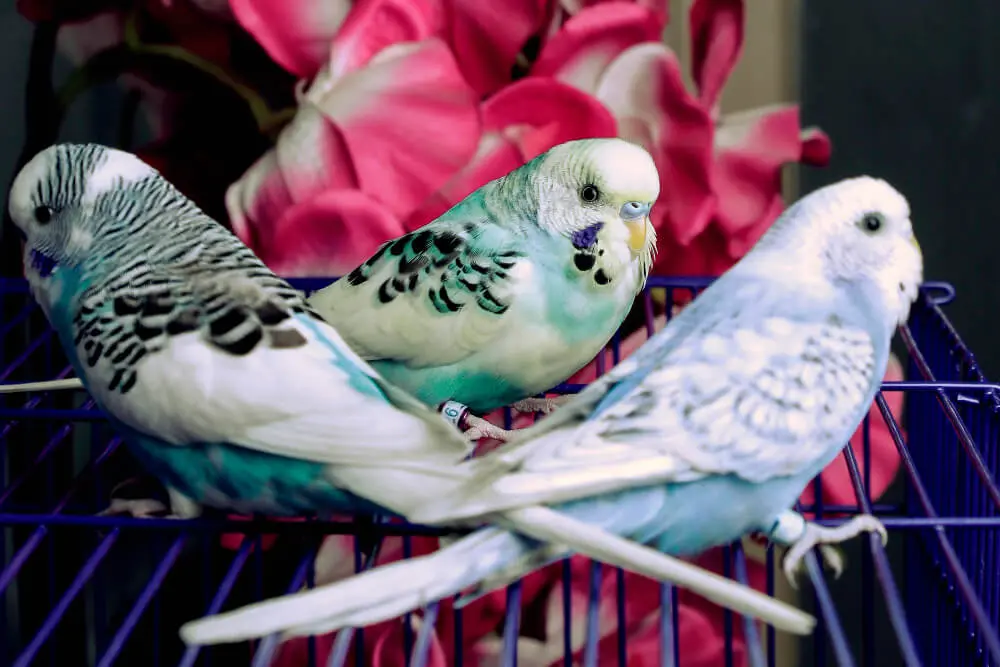
Three budgerigars perched on a cage, with a vibrant floral background accentuating their feather patterns.
Understanding the factors that influence pattern development, such as genetics, environmental conditions, and selective breeding, enhances our appreciation for these birds. It also provides valuable insights for those interested in breeding budgerigars for specific patterns, ensuring that each new generation of budgies continues to captivate with its vibrant diversity.
Caring for budgerigars with unique patterns requires attention to their diet, health, and environment. By providing the right nutrition, regular health monitoring, and a stimulating living space, we can ensure that these beautiful birds thrive. Social interaction and companionship further enrich their lives, making them happy and healthy pets.
In the end, the diversity of Budgerigar patterns is a celebration of nature’s creativity and adaptability. Whether you’re a breeder aiming to produce specific patterns or a budgie owner marveling at the beauty of your pet, the intricate and varied patterns of these birds offer endless fascination and joy.
By appreciating and caring for budgerigars with an understanding of their unique needs, we honor the natural wonder of their patterns and contribute to their continued health and happiness. Embrace the diversity of Budgerigar patterns, and let these charming birds bring color and joy into your life.

